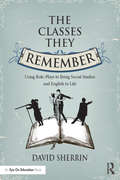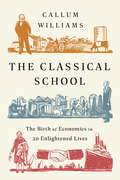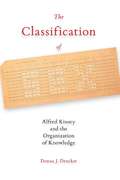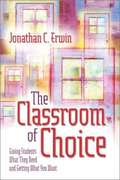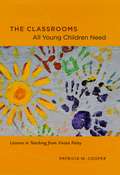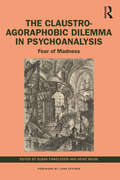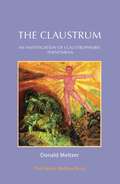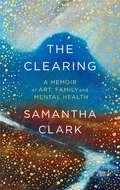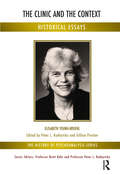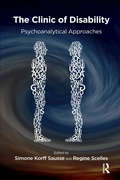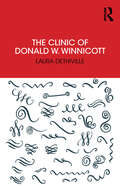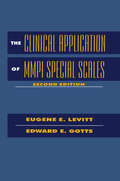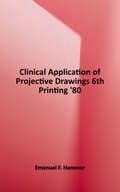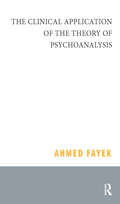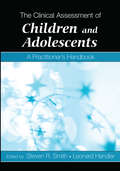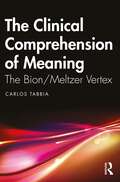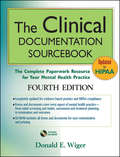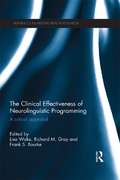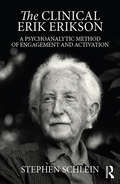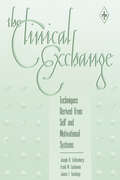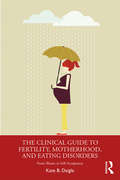- Table View
- List View
The Classes They Remember: Using Role-plays And Mock Trials To Bring Social Studies And English To Life
by David SherrinLearn how to use role-plays to bring history and literature to life! When students take on the roles of historical or literary figures, they develop a greater understanding of characters’ identities and motivations, and are able to more deeply explore and reflect upon key issues and themes. In this new book from award-winning teacher David Sherrin, you’ll find out how this lively instructional format will make teaching a more immersive, interactive, and memorable experience for your middle school and high school students. The book includes: <P><P> A clear how-to guide to get the most out of role-playing in your class; Ready-made units and lessons to get you started right away, complete with sample scripts, scaffolding worksheets, and assessment rubrics; Templates and step-by-step instructions to help you design your own role-plays. <P><P> The pre-made units, which Sherrin spent years refining in his classroom, cover historical topics such as the rise of Nazi Germany and the Spanish conquest of the Aztecs. You’ll also find fun and interactive role-plays based on literary works like The Pearl and Fences. These lessons will help students at all ability levels to become better communicators, problem-solvers, and creative thinkers.
The Classical School: The Birth of Economics in 20 Enlightened Lives
by Callum WilliamsA fascinating chronicle of the lives of 20 economists who played major roles in the evolution of global economic thought.What was Adam Smith really talking about when he mentioned the "invisible hand"? Did Karl Marx really predict the end of capitalism? Did Thomas Malthus (from whose name the word "Malthusian" derives) really believe that famines were desirable?In The Classical School, Callum Williams debunks popular myths about these great economists, and explains the significance of their ideas in an engaging way. After reading this book, you will know much more about the very famous (Smith, Ricardo, Mill) and the not-quite-so-famous (Bernard de Mandeville, Friedrich Engels, Jean-Baptiste Say). The book offers an assessment of what they wrote, the impact it had, and the worthiness of their ideas. It's far from the final word on any of these people, but a useful way of understanding what they were all about, at a time when understanding these economic giants is perhaps more important than ever.
The Classification Of Sex: Alfred Kinsey And The Organization Of Knowledge
by Donna DruckerAlfred C. Kinsey’s revolutionary studies of human sexual behavior are world-renowned. His meticulous methods of data collection, from comprehensive entomological assemblies to personal sex history interviews, raised the bar for empirical evidence to an entirely new level. In The Classification of Sex, Donna J. Drucker presents an original analysis of Kinsey’s scientific career in order to uncover the roots of his research methods. She describes how his enduring interest as an entomologist and biologist in the compilation and organization of mass data sets structured each of his classification projects. As Drucker shows, Kinsey’s lifelong mission was to find scientific truth in numbers and through observation—and to record without prejudice in the spirit of a true taxonomist. <p><p> Kinsey’s doctoral work included extensive research of the gall wasp, where he gathered and recorded variations in over six million specimens. His classification and reclassification of Cynips led to the speciation of the genus that remains today. During his graduate training, Kinsey developed a strong interest in evolution and the links between entomological and human behavior studies. In 1920, he joined Indiana University as a professor in zoology, and soon published an introductory text on biology, followed by a coauthored field guide to edible wild plants. <p> In 1938, Kinsey began teaching a noncredit course on marriage, where he openly discussed sexual behavior and espoused equal opportunity for orgasmic satisfaction in marital relationships. Soon after, he began gathering case histories of sexual behavior. As a pioneer in the nascent field of sexology, Kinsey saw that the key to its cogency was grounded in observation combined with the collection and classification of mass data. To support the institutionalization of his work, he cofounded the Institute for Sex Research at Indiana University in 1947. He and his staff eventually conducted over eighteen thousand personal interviews about sexual behavior, and in 1948 he published Sexual Behavior in the Human Male, to be followed in 1953 by Sexual Behavior in the Human Female. <p> As Drucker’s study shows, Kinsey’s scientific rigor and his early use of data recording methods and observational studies were unparalleled in his field. Those practices shaped his entire career and produced a wellspring of new information, whether he was studying gall wasp wings, writing biology textbooks, tracing patterns of evolution, or developing a universal theory of human sexuality.
The Classroom of Choice: Giving Students What They Need and Getting What You Want
by Jonathan C. ErwinProvides a variety of strategies for teaching and classroom management.
The Classrooms All Young Children Need
by Patricia M. CooperThe book identifies a pedagogical model organized around two complementary principles: a curriculum that promotes play and imagination, and the idea of classrooms as fair places where young children of every color, ability, and disposition are welcome.
The Claustro-Agoraphobic Dilemma in Psychoanalysis: Fear of Madness
by Heinz Weiss Susan FinkelsteinThis collection addresses the theory of claustro-agoraphobic anxieties and schizoid phenomena. It provides psychoanalytic case studies of the transference and counter-transference dynamic inherent in these agonizing disorders. In The Claustro-Agoraphobic Dilemma in Psychoanalysis: Fear of Madness, Susan Finkelstein and Heinz Weiss gather both classic papers and new essays, presenting a timely assessment of claustro-agoraphobia as first developed by Henri Rey. This volume includes papers by Helene Deutsch, Bertram Lewin, Edoardo Weiss, Esther Bick, Donald Meltzer, Albert Mason, John Steiner, and Claudia Frank, as well as a chapter by Kristin White on working remotely with psychoanalytic patients during the Covid-19 pandemic. Applying a Freudian, Kleinian, and Bionian methodology, this collection argues for a long-term approach to psychoanalytic treatment in order to help claustro-agoraphobic patients work through the unconscious conflicts that interfere with their capacity to engage in a committed relationship. This book is essential reading for psychoanalysts in practice and training and will appeal to academics and historians interested in the universality of spiritual and mythic motifs.
The Claustrum: An Investigation of Claustrophobic Phenomena
by Donald MeltzerUsing the Kleinian concept of projective-identification, with special reference to intrusive identification with internal objects, this work examines claustrophobic phenomena and its relations to the treatment of borderline and adolescent patients.
The Clearing: A memoir of art, family and mental health
by Samantha ClarkThis house has been a regular presence in my life for as long as I can remember. My heart has sunk a little every time I walk in . . .Samantha Clark enjoyed a busy career as an artist before returning home to Glasgow to take care of the house that her parents had left behind. Moving from room to room, sifting through the clutter of belongings, reflecting on her mother's long, sedated years of mental illness and her father's retreat to the world of amateur radio and model planes, Samantha began to contemplate her inheritance.A need for creativity and a desire for solitude had sprung up from a childhood shaped by anxiety and confusion. Weaving in the works and lives of others, including celebrated painter Agnes Martin and scientist of dark matter Vera Rubin, The Clearing is a powerful account of what we must do with the things we cannot know.'Samantha Clark writes on the subtle edge of words and thought. She renders the world within and the world of ideas with electric sensitivity and acute intelligence' Jay Griffiths
The Client Who Changed Me: Stories of Therapist Personal Transformation
by Jeffrey A. Kottler Jon Carlson<p>Although the impact that clients can have on therapists is well-known, most work on the subject consists of dire warnings: mental health professionals are taught early on to be on their guard for burnout, compassion fatigue, and countertransference. However, while these professional hazards are very real, the scholarly focus on the negative potential of the client-counselor relationship often implies that no good can come of allowing oneself to get too close to a client's issues. This sentiment obscures what every therapist knows to be true: that the client-counselor relationship can also effect powerful positive transformations in a therapist's own life. <p><i>The Client Who Changed Me</i> is Jeffrey Kottler and Jon Carlson's testimony to the significant and often life-changing ways in which therapists have been changed by their patients. Kottler and Carlson draw not only upon their own extensive experience - between them, they have more than fifty years in the field - but also upon lengthy interviews with dozens of the country's foremost therapists and theorists. This novel work presents readers with a truly unique perspective on the business of therapy: not merely how it appears externally, but how practitioners experience it internally. Although these stories paint a complex and multi-layered portrait of the client-counselor relationship, they all demonstrate the profound and unexpected rewards that the profession has to offer.</p>
The Clinic and the Context: Historical Essays (The History of Psychoanalysis Series)
by Elisabeth Young-BruehlThis book comprises a collection of the distinguished psychoanalyst Elisabeth Young-Bruehl 's papers ranging from 'Psychoanalysis and Social Democracy', 'Civilization and its Dream of Contentment', 'Reflections on Women and Psychoanalysis' and 'Psychobiography and Character Study'.
The Clinic of Disability: Psychoanalytical Approaches
by Simone Korff SausseThis publication brings together eleven articles on the clinical treatment of disability from French researchers in the fields of psychology, anthropology, psychiatry, and philosophy. The authors all have practical experience in the field and most are clinicians sharing a common psychoanalytical epistemology. The diverse nature of their contributions opens a window onto the mental life of people affected by various deficiencies, be they cognitive, motor, sensory or even multiple, and of those close to them, at all ages. The work provides English-speaking readers with an insight into the way French authors raise the relevant issues, elaborate theories relating to clinical disability management and implement innovative practices. Each of the authors develops an original approach, affording recognition to the subjectivity and intersubjectivity of the disabled person and those dear to them, intimating that the disability (as with all human experience) is all about the relation existing between the person concerned and their life story, and also their relations with others - with the society and culture in which the condition emerges and evolves throughout life.
The Clinic of Donald W. Winnicott
by Laura DethivillePaediatric psychoanalyst Donald W. Winnicott is widely recognized as a remarkable clinician. Deprivation, regression, play, antisocial tendencies and "the use of the object" are part of the many clinical conceptions he conceived, and here Laura Dethiville explains each in a clear and precise way, highlighting Winnicott’s originality and enduring relevance. The Clinic of Donald W. Winnicott offers all readers a glimpse of what Winnicott brings to the understanding of the human being, and will appeal to students new to his work, as well as practitioners looking for a concise overview of his work.
The Clinical Application of MMPI Special Scales
by Eugene E. Levitt Edward E. GottsThis second edition continues to present the following special features of its highly successful predecessor: * an analysis of the major partitionings of the MMPI into special scales in terms of their clinical usefulness, resulting in the selection of those scales that most discriminatingly and non-redundantly represent the core psychological traits and qualities captured by the MMPI; * a number of individually developed scales that tap into additional aspects of validity, psychopathology, and adjustment and personality; * the Indiana Special Scales which sample additional areas that were not as well identified or delineated by prior scale development; * a critique of the foregoing selections in light of the extant MMPI literature (which this second edition further expands up to the current time) and of a major investigation at the Indiana University Medical School of the conjoint use of special scales; * a critique of the shortcomings of high-point codes; * a detailed, categorized listing of the most useful scales in empirical clusters based on their established intercorrelations such that not only scale elevations but also interrelations (and the departures from the expected) of scales become clinically interpretable; * an exploration of the interrelationships between Rorschach and MMPI variables, leading to complementary use of these two instruments. This second edition also takes into account the development of MMPI-2 and the status of its new special scales vis-a-vis the established scales derived from the original MMPI. In so doing, it indicates why the original scales continue to offer substantial advantages over the MMPI-2 scales. It further examines changes in the nosology of personality disorders and proposes special scale markers for these disorders as they have been clarified progressively through DSM-IV. This volume offers the MMPI user a library of psychological report statements based on special scale interpretation, with recommended score ranges and cutting points for particular inferences. These latter features appear together as an appendix styled as "The Human Computer." Unlike the typical computer-generated report, this appendix makes all decision rules explicit, thereby permitting the user to use the library of statements with full knowledge of their applicability. By retaining the element of clinical judgment -- the human dimension of inference -- the user is enabled to better integrate MMPI special scale findings with data from other sources while in the process of crafting the report. All of these new features are accompanied by applicable literature citations.
The Clinical Application of Projective Drawings
by Emanuel F. HammerEdited by Emanuel F. Hammer, New York University, New York, New York. (With 14 Contributors) On its way to becoming the classic in the field of projective drawings, this book provides a grounding in fundamentals and goes on to consider the differential diagnosis, appraisal of psychodynamics, conflict and defense, psychological resources as treatment potentials, and projective drawing usage in therapy. In addition to Buck's H-T-P Techniques and Machover's Draw-A-Person Test, it also includes the Draw-A-Family Procedure, Harrower's Unpleasant Concept Test, Kinget's Drawing Completion Test, The Draw-A-Person-In-The-Rain Test which elicits clues to the self-concept under conditions of environmental stress, the Draw-An-Animal Concept used to disclose the biological side of the biosocial coin, the Eight Card Redrawing Test which delves into the deepest layers of the subject's psychosexual identification, and free doodles.
The Clinical Application of the Theory of Psychoanalysis
by Ahmed FayekPsychoanalysis - the one that we are familiar with - started in the clinical field. Freud and Breuer made some strides in the treatment of hysteria using hypnosis. They put together a theory of psychopathology based on two basic notions: conflicts between acceptable and unacceptable impulses (ideas, desires, fantasies, etc.), and the repression of the unacceptable impulses causing the formation of symptoms. Under hypnosis, the patients were given the chance to abreact the repressed, and the therapeutic endeavour was to allow catharsis, hence the origin of the term "catharsis theory" regarding this phase of hypnosis. However, the real breakthrough in psychoanalysis came to Freud in intuitions about matters from outside the field of pathology and the clinic, and without the help of hypnosis. They came from ordinary, even banal, phenomena like dreams, slips of the tongue, and jokes. In this book, the author covers the difference between a modified theory of catharsis and a theory of psychoanalysis, as well as the importance of psychodynamic diagnosis in the practice of psychoanalysis.
The Clinical Assessment Workbook Balancing Strengths and Differential Diagnosis Second Edition
by Elizabeth PomeroyThis practical workbook facilitates readers' understanding of the DSM-5 and other texts related to the diagnoses of mental disorders, enhancing their ability to assess their clients' strengths and to diagnose any emotional difficulties the clients may be experiencing. As a workbook, it offers a wealth of real life examples and exercises, providing users with the opportunity to practice their assessment skills in a classroom environment prior to entering the field as a mental health professional. Readers learn the various diagnostic categories of the DSM-5-along with dual diagnoses, symptom formulation, and the overlap between diagnostic categories-as well as how to apply these categories to clients they will be seeing in practice.
The Clinical Assessment of Children and Adolescents: A Practitioner's Handbook
by Leonard Handler Steven R. SmithThis book highlights assessment techniques, issues, and procedures that appeal to practicing clinicians. Rather than a comprehensive handbook of various tests and measures, The Clinical Assessment of Children and Adolescents is a practitioner-friendly text that provides guidance for test selection, interpretation, and application. With topics ranging from personality assessment to behavioral assessment to the assessment of depression and thought disorder, the leaders in the field of child and adolescent measurement outline selection and interpretation of measures in a manner that is most relevant to clinicians and graduate students. Each chapter makes use of extensive case material in order to highlight issues of applicability.
The Clinical Comprehension of Meaning: The Bion/Meltzer Vertex
by Carlos TabbiaIn The Clinical Comprehension of Meaning, Carlos Tabbia addresses fundamental questions of psychoanalytic theory and technique, unfolding them for the reader in an elegant, passionate, and poetic style. This book illustrates three pillars of a psychoanalytic clinic: the structure of the personality, the development of thought, and the ability to foster close relationships with clients. These three pillars show the conditions for the creation of meanings and the difficulties that can be manifested in fanatical functioning, psychosomatic disorders and dreaming, as well as isolation and boredom in adolescents. Using clinical vignettes throughout, Tabbia also analyses the issues surrounding the establishment of an intimate relationship, as well as the issues psychoanalysts must face within themselves. Throughout the volume, Tabbia looks to the work of Bion, Meltzer, Freud, and Klein as well as philosophers such as Plato, Wittgenstein, Russell, Max Scheler, and Levinas, and others such as poets and painters. Including a prologue by Alberto Hahn and translated into English for the first time, this seminal text will be of interest to psychoanalysts and psychotherapists, as well as students and candidates undertaking psychoanalytic training.
The Clinical Documentation Sourcebook
by Wiger Donald E.All the forms, handouts, and records mental health professionals need to meet documentation requirements-fully revised and updated The paperwork required when providing mental health services continues to mount. Keeping records for managed care reimbursement, accreditation agencies, protection in the event of lawsuits, and to help streamline patient care in solo and group practices, inpatient facilities, and hospitals has become increasingly important. Now fully updated and revised, the Fourth Edition of The Clinical Documentation Sourcebook provides you with a full range of forms, checklists, and clinical records essential for effectively and efficiently managing and protecting your practice. The Fourth Edition offers: Seventy-two ready-to-copy forms appropriate for use with a broad range of clients including children, couples, and families Updated coverage for HIPAA compliance, reflecting the latest The Joint Commission (TJC) and CARF regulations A new chapter covering the most current format on screening information for referral sources Increased coverage of clinical outcomes to support the latest advancements in evidence-based treatment A CD-ROM with all the ready-to-copy forms in Microsoft® Word format, allowing for customization to suit a variety of practices From intake to diagnosis and treatment through discharge and outcome assessment, The Clinical Documentation Sourcebook, Fourth Edition offers sample forms for every stage of the treatment process. Greatly expanded from the Third Edition, the book now includes twenty-six fully completed forms illustrating the proper way to fill them out. Note: CD-ROM/DVD and other supplementary materials are not included as part of eBook file.
The Clinical Effectiveness of Neurolinguistic Programming: A Critical Appraisal (Advances in Mental Health Research)
by Lisa Wake Richard M. Gray Frank S. BourkeDespite widespread use, Neurolinguistic Programming (NLP) is a topic of much debate, often receiving criticism from academic and professional sectors. In this book international academics, researchers and therapists are brought together to examine the current evidence of the clinical efficacy of NLP techniques, considering how NLP can be effective in facilitating change, enrichment and symptom relief. Lisa Wake and her colleagues provide a critical appraisal of evidence-based research in the area to indicate the benefits of the approach and identify the need for an increase in randomized well-controlled clinical trials. Contributors also explore how NLP has been used to treat various disorders including: post-traumatic stress disorder phobias addictions anxiety disorders mild depression. Illustrated throughout with clinical examples and case studies, this book is key reading for practitioners and researchers interested in NLP, as well as postgraduate students.
The Clinical Erik Erikson: A Psychoanalytic Method of Engagement and Activation
by Stephen SchleinThe twentieth century has been described as the time of man’s discovery of himself; few have contributed more to this cause than Erik Erikson. The Clinical Erik Erikson: A psychoanalytic method of engagement and activation highlights Erikson’s transforming contributions to the field of psychoanalysis and honors his legacy by providing unpublished clinical case illustrations of his psychotherapeutic work. The publication of case material—simple memorable fragments and clinical vignettes— brings the reader into Erikson’s consultation room, providing a portrait of his clinical technique and demonstrating how he actually worked. Stephen Schlein, an authority on Erikson, presents an illuminating account of Erikson’s pioneering work through an exhaustive search of his early monographs on child psychoanalysis, clinical writings, psychotherapeutic case studies, and participation at case conferences at The Austen Riggs Center. Erikson’s writings reveal a psychoanalytic method of extraordinary richness that emphasizes essential ingredients of an interpersonal-relational clinical method and articulates interactional dimensions that have restorative potential. His vision focuses on the interpersonal relationship, its powerful affects, and a belief that human beings have a potent capacity for real change. This book will be essential reading for psychoanalysts and psychoanalytic psychotherapists.
The Clinical Exchange: Techniques Derived from Self and Motivational Systems (Psychoanalytic Inquiry Book Series #16)
by Joseph D. Lichtenberg Frank M. Lachmann James L. FosshageIn this practical sequel to the same authors' Self and Motivational Systems (TAP, 1992), Lichtenberg, Lachmann, and Fosshage offer ten principles of technique to guide the clinical exchange. These principles, which pertain equally to exploratory psychotherapy and psychoanalysis, integrate the findings of self psychology with recent developmental research that has refined our understanding of the self as a center of experience and motivation. The ten principles of technique not only provide a valuable framework for attending to a wide range of motivations, but lead to basic revisions in the theory and technical management of affects, transference, and dreams.
The Clinical Guide to Fertility, Motherhood, and Eating Disorders: From Shame to Self-Acceptance
by Kate B. DaigleThis book is a comprehensive guide to addressing, working with, and healing from emotional struggles related to fertility and eating disorders. Covering the emotional, psychological and physical impact of anorexia nervosa, bulimia and binge eating disorder, this book explores the lived experience of numerous women and men who have lived with eating disorders, fertility, and parenthood. It delves into research on medical complications that can affect fertility, attachment, the experience of shame, adjustment to the postpartum period, and offers clinical tools for therapists to use to support clients from a weight and body neutral perspective. Those who read this book will come away with a renewed sense of hope for recovery and healing from serious mental illnesses, and the notion that the value of having a family may be stronger than the eating disorder itself. The only book of its kind, The Clinical Guide to Fertility, Motherhood and Eating Disorders will be useful to practitioners, therapists, and scholars alike.
The Clinical Handbook of Mindfulness-integrated Cognitive Behavior Therapy: A Step-by-Step Guide for Therapists
by Bruno A. Cayoun Sarah E. Francis Alice G. ShiresThe essential guide to MiCBT for therapists working in clinical settings The Clinical Handbook of Mindfulness-integrated Cognitive Behavior Therapy offers therapists working in clinical settings a practical set of evidence-based techniques derived from mindfulness (vipassana) training and the principles of Cognitive Behavior Therapy. The increasing popularity of Mindfulness-integrated Cognitive Behavior Therapy (MiCBT) is principally attributed to its transdiagnostic applications. It offers novel tools that address a broad range of psychological disorders both acute and chronic, including those with complex comorbidities, and helps prevent relapse. The authoritative guide to this unique approach includes: A clear explanation of MiCBT’s origins and development, structure and content, scientific underpinnings and supporting empirical evidence A comprehensive guide to the 10-session MiCBT program for groups and individual clients that includes worksheets and handouts for each session and suggestions to overcome common difficulties A presentation of the research and practical experience of the authors, noted experts in the field of MiCBT Written for mental health therapists working with groups and individual clients, The Clinical Handbook of Mindfulness-integrated Cognitive Behavior Therapy offers an effective guide for implementing the principles of MiCBT within their professional practice.
The Clinical Interpretation of MMPI-2: A Content Cluster Approach
by Edward E. Gotts Thomas E. KnudsenIn a managed care era, the MMPI-2 is becoming an overloaded workhorse, required to generate more and more of the assessments that a battery of instruments once did. Though all now rely on the MMPI-2 for good reasons, and the MMPI has fallen out of use entirely, some important and clinically useful scales were lost in the transition. Edward Gotts and Thomas Knudsen have recovered these scales and integrated them with all the standard MMPI-2 scales, the recently published Restructured Clinical Scales, and a number of scales they have constructed to assess positive strengths and coping abilities, and response consistency-inconsistency. This book lays out their new Content Cluster interpretive approach.Drawing on data from a large psychiatric inpatient sample, they present item composition, reliability, and validity information for each recovered and new scale, and convincingly demonstrate that their new Content Cluster approach results in improved prediction and interpretive power. They also show how to conjoin Rorschach and MMPI-2 results in more effective assessment strategies, and how to tie MMPI-2 results to specific DSM-IV criteria.The Clinical Interpretation of the MMPI-2: A Content Cluster Approach offers psychologists essential new tools for clinical and personality assessment.
